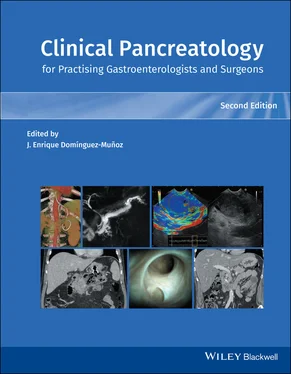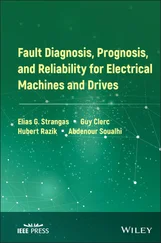29 30 Morató O, Poves I, Ilzarbe L, et al. Minimally invasive surgery in the era of step‐up approach for treatment of severe acute pancreatitis. Int J Surg 2018; 51:164–169.
30 31 Eickhoff RM, Steinbusch J, Seppelt P, et al. Videoassistiertes retroperitoneales DébridementVideo‐assisted retroperitoneal debridement. Der Chir 2017; 88(9):785–791.
31 32 Wani SV, Patankar RV, Mathur SK. Minimally invasive approach to pancreatic necrosectomy. J Laparoendosc Adv Surg Tech A 2011; 21(2):131–136.
32 33 Parekh D. Laparoscopic‐assisted pancreatic necrosectomy. Arch Surg 2006; 141(9):895.
33 34 Castellanos G, Piñero A, Parrilla P. Is there a place for laparoscopic surgery in the management of acute pancreatitis? In: Domínguez Muñoz JE (ed.) Clinical Pancreatology for Practising Gastroenterologists and Surgeons. Oxford: Blackwell Publishing, 2005:156–165.
34 35 Worhunsky DJ, Qadan M, Dua MM, et al. Laparoscopic transgastric necrosectomy for the management of pancreatic necrosis. J Am Coll Surg 2014; 219(4):735–743.
1 †Deceased September 2019.
16 Endoscopic Necrosectomy in Clinical Practice : Indications, Technical Issues, and Optimal Timing
Jodie A. Barkin1 and Andres Gelrud2
1 Department of Medicine, Division of Gastroenterology, Leonard M. Miller School of Medicine, University of Miami, Miami, FL, USA
2 GastroHealth and Miami Cancer Institute, Miami, FL, USA
Acute pancreatitis (AP) is the third leading cause of gastroenterology‐related hospitalizations in the United States, accounting for approximately 280 000 admissions annually and more than US$2 billion in annual healthcare costs [1,2]. Despite advances in treatment algorithms over time, AP has an associated mortality rate of approximately 5%, with further increases to greater than 15% in those with severe AP in the presence of multiorgan failure [3]. Interstitial edematous pancreatitis accounts for the majority of AP cases; under 10% of AP patients develop necrotizing pancreatitis with the presence of pancreatic and/or peripancreatic tissue necrosis. While necrosis may be seen on imaging at presentation or early in the disease course, necrosis may slowly evolve over a number of days after the onset of symptoms, and lack of necrosis initially does not preclude its development thereafter [4,5]. If a concern exists for worsening clinical status days to weeks after prior imaging, consideration for repeat imaging to evaluate for complications including the presence of fluid and/or necrotic collections is advisable. The 2012 Revised Atlanta Classification guides the characterization of these local complications based on the presence or absence of tissue debris in the collection and on a time course after development to allow maturation of the collection with a well‐defined wall [6]. There are four types of local collections associated with AP, including acute fluid collection (AFC), pancreatic pseudocyst (PP), acute necrotic collection (ANC), and walled‐off necrosis (WON). AFCs develop early (under four weeks post AP episode) in interstitial edematous AP, contain only fluid without solid debris, classically appear homogeneous on cross‐sectional contrast‐enhanced imaging, and likely lack a well‐defined wall or capsule. AFCs persisting beyond four weeks post AP are reclassified as PPs containing just fluid without solid debris and, importantly, having the presence of a clearly demarcated capsule. In contrast, collections in which solid debris is seen are classified as ANCs or WON depending on time course post AP and presence or absence of a clearly defined wall. ANCs develop within four weeks of necrotizing AP, contain both fluid and solid debris internally, and lack a clear wall. Once a wall has formed, again usually after four weeks, these are reclassified as WON. Superimposed infection may occur in approximately 40–70% of patients with necrotizing AP, with an associated drastic increase in mortality, from 15% in those with sterile necrosis to roughly 40% in those with infected necrosis [7]. Oftentimes, differentiation of AFC from ANC may be challenging early on as both may appear homogeneous with fluid consistency on imaging. Delaying subsequent follow‐up imaging for one to two weeks if clinical status is stable is advisable to maximize the informative value of subsequent scans in differentiating AFC from ANC.
Most AFCs and ANCs will spontaneously resolve, with only a proportion persisting beyond four weeks and going on to develop a clearly defined capsule to become PP or WON. Interestingly, most ANCs will spontaneously resolve over time, and even in those who develop WON, approximately half will spontaneously resolve without intervention in a six‐month period [8]. The critical juncture is to decide which patients with PP or WON require intervention, as intervention in AFC and ANC should be delayed until clear maturation of the wall is seen. The primary criterion for need to intervene is the presence of symptoms. Asymptomatic patients should be conservatively managed and observed regardless of collection size, while those who are symptomatic should be evaluated for potential intervention. Historically, open surgical intervention was the primary option especially for patients with large WON; however, patients often had prolonged hospitalizations with substantial morbidity and mortality despite the most gifted of surgeons. Currently available approaches to drainage and debridement include endoscopic, percutaneous, surgical, and combination therapies. The decision to intervene should not be taken lightly. Some of the most common indications for intervention in PP or WON include obstruction of adjacent viscera (gastric outlet obstruction, pancreatobiliary obstruction), abdominal pain, nausea/vomiting or early satiety, infection, and rarely rupture or bleeding (usually handled surgically). Drainage should not be undertaken in AFC or ANC until there is a clearly matured wall, and percutaneous and surgical interventions should be delayed if possible for four weeks to enable adequate encapsulation as the success of endoscopic intervention is directly correlated with the degree of encapsulation, while early intervention (before four weeks) is associated with suboptimal outcomes [9,10].
Management of Symptomatic Pseudocysts
Endoscopic transmural drainage of PP was first described in 1985 and has subsequently evolved [11]. Endoscopic drainage has become the preferred standard of care for symptomatic PP. In a single‐center, randomized prospective trial of 40 patients with PP by Varadarajulu et al. [12], endoscopic cystgastrostomy ( n = 20) was equally technically effective as surgical cystgastrostomy ( n = 20); endoscopic drainage was associated with the significant benefits of shortened length of hospital stay and lower associated hospital costs, with a greater than 50% reduction in both parameters in the endoscopic group. It is of critical importance to accurately differentiate between PP and WON as the subsequent management strategies are markedly different. At times, computed tomography (CT) may miss components of solid debris inside the collection, which may be seen on magnetic resonance imaging (MRI) or endoscopic ultrasound (EUS). Additionally, EUS not only allows real‐time assessment of a collection’s characteristics but also has the ability to provide intervention if indicated. PPs should be distinguished from potential cystic neoplasms. Attention to a careful history regarding pancreatitis is helpful as a preceding history of pancreatitis increases the likelihood of the lesion being a PP whereas no history of pancreatitis favors the possibility of a cystic neoplasm. The approach to drainage of PPs will be dictated based on their size, location, anatomy, and any component of pancreatic ductal disruption that may be present. In the case of ductal disruptions, endoscopic retrograde cholangiopancreatography (ERCP) may be undertaken to enable transpapillary drainage to correct the underlying etiology in addition to other therapeutic modalities for PP drainage. The vast majority of these PPs are now drained transmurally, primarily under EUS guidance. This drainage can be done using plastic double‐pigtail stents or lumen apposing metal stents (LAMS).
Читать дальше












